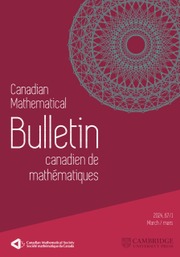No CrossRef data available.
Article contents
A new complemented subspace for the Lorentz sequence spaces, with an application to its lattice of closed ideals
Part of:
Normed linear spaces and Banach spaces; Banach lattices
Linear spaces and algebras of operators
Published online by Cambridge University Press: 02 August 2021
Abstract
We show that every Lorentz sequence space  $d(\textbf {w},p)$ admits a 1-complemented subspace Y distinct from
$d(\textbf {w},p)$ admits a 1-complemented subspace Y distinct from  $\ell _p$ and containing no isomorph of
$\ell _p$ and containing no isomorph of  $d(\textbf {w},p)$. In the general case, this is only the second nontrivial complemented subspace in
$d(\textbf {w},p)$. In the general case, this is only the second nontrivial complemented subspace in  $d(\textbf {w},p)$ yet known. We also give an explicit representation of Y in the special case
$d(\textbf {w},p)$ yet known. We also give an explicit representation of Y in the special case  $\textbf {w}=(n^{-\theta })_{n=1}^\infty $ (
$\textbf {w}=(n^{-\theta })_{n=1}^\infty $ ( $0<\theta <1$) as the
$0<\theta <1$) as the  $\ell _p$-sum of finite-dimensional copies of
$\ell _p$-sum of finite-dimensional copies of  $d(\textbf {w},p)$. As an application, we find a sixth distinct element in the lattice of closed ideals of
$d(\textbf {w},p)$. As an application, we find a sixth distinct element in the lattice of closed ideals of  $\mathcal {L}(d(\textbf {w},p))$, of which only five were previously known in the general case.
$\mathcal {L}(d(\textbf {w},p))$, of which only five were previously known in the general case.
MSC classification
Information
- Type
- Article
- Information
- Copyright
- © Canadian Mathematical Society 2021
References
Altshuler, Z., Casazza, P. G., and Lin, B.-L.,
On symmetric basic sequences in Lorentz sequence spaces
. Israel J. Math. 15(1973), no. 2, 140–155.CrossRefGoogle Scholar
Casazza, P. G. and Lin, B.-L.,
On symmetric basic sequences in Lorentz sequence spaces II
. Israel J. Math. 17(1974), 191–218.10.1007/BF02882238CrossRefGoogle Scholar
Heinrich, S.,
Ultraproducts in Banach space theory
. J. Reine Angew. Math. 313(1980), 72–104.Google Scholar
Johnson, W. B. and Lindenstrauss, J.,
Basic concepts in the geometry of Banach spaces
. In: Johnson, W. B. and Lindenstrauss, J. (eds.), Handbook of the geometry of Banach spaces, Vol. 1, Elsevier, Amsterdam, 2001, pp. 1–84.CrossRefGoogle Scholar
Kadec, M. I. and Pełczyński, A.,
Bases, lacunary sequences and complemented subspaces in the spaces Lp
. Studia Math. 21(1962), 161–176.10.4064/sm-21-2-161-176CrossRefGoogle Scholar
Kaminska, A., Popov, A. I., Spinu, E., Tcaciuc, A., and Troitsky, V. G.,
Norm closed operator ideals in Lorentz sequence spaces
. J. Math. Anal. Appl. 389(2012), no. 1, 247–260.CrossRefGoogle Scholar
Laustsen, N. J., Loy, R. J., and Read, C. J.,
The lattice of closed ideals in the Banach algebra of operators on certain Banach spaces
. J. Funct. Anal. 214(2004), 106–131.CrossRefGoogle Scholar
Lindenstrauss, J. and Tzafriri, L., Classical Banach spaces I, sequence spaces, Springer, Berlin, 1977.Google Scholar
Wallis, B.,
Closed ideals of operators acting on some families of sequence spaces
. Banach J. Math. Anal. 14(2020), no. 1, 98–115.CrossRefGoogle Scholar


